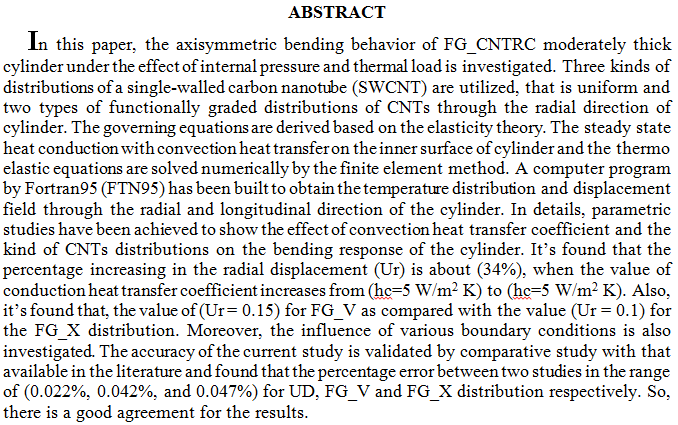
In this paper, we show that for the alternating group An, the class C of n- cycle, CC covers An for n when n = 4k + 1 > 5 and odd. This class splits into two classes of An denoted by C and C/, CC= C/C/ was found.
Abstract
The population is sets of vocabulary common in character or characters and it’s study subject or research . statistically , this sets is called study population (or abridgement population ) such as set of person or trees of special kind of fruits or animals or product any country for any commodity through infinite temporal period term ... etc.
The population maybe finite if we can enclose the number of its members such as the students of finite school grade . and maybe infinite if we can not enclose the number of it is members such as stars or aquatic creatures in the sea . when we study any character for population the statistical data is concentrate by two metho
... Show MoreNanostructured Al2O3has been applied as a protective coating against corrosion of the carbon steel (C.S) in seawater environment (3.5% NaCl) at temperatures range (298-328)K. Aluminananoparticles were deposited on carbon steel substrates by cathodic electrophoretic deposition (EPD) with ethanol as suspension medium and poly(acrylic acid) (PAA) as polymeric charging agent. Meanwhile, thesurface morphology was examined using Atomic-force microscopy (AFM). The cross-section AFM showed that the particles sizes for the Al2O3 NPs is around 60-80 nm. The anticorrosion behaviour of coated C.S was investigated in 3.5% NaCl at temperature range 298-328 K by potentiodynamic polarization measurements. Results show that using PAA in suspension coat incr
... Show More (12)
(12)
 (37)
(37)
 (40)
(40)
This dissertation studies the application of equivalence theory developed by Mona Baker in translating Persian to Arabic. Among various translation methodologies, Mona Baker’s bottom-up equivalency approach is unique in several ways. Baker’s translation approach is a multistep process. It starts with studying the smallest linguistic unit, “the word”, and then evolves above the level of words leading to the translation of the entire text. Equivalence at the word level, i.e., word for word method, is the core point of Baker’s approach.
This study evaluates the use of Baker’s approach in translation from Persian to Arabic, mainly because finding the correct equivalence is a major challenge in this translation. Additionall
... Show MoreBackground: This in vitro study evaluated the fracture resistance of weakened endodontically treated premolars with class II MOD cavities restored with different composite restorations (Low-shrinkage Filtek P90, nanohybrid Filtek Z250 XT and SDR bulk fill). The type and mode of fracture were also assessed for all the experimental groups. Materials and Method: Fifty human adult maxillary premolar teeth were selected for this study. Standardized extensive class II MOD cavities with endodontic treatment were prepared for all teeth, except those that were saved as intact control. The teeth were divided into five groups of ten teeth each (n=10): (Group 1) intact control group, (Group 2) unrestored teeth with endodontic treatment, (Group 3) resto
... Show MoreThe Sliding Mode Control (SMC) has been among powerful control techniques increasingly. Much attention is paid to both theoretical and practical aspects of disciplines due to their distinctive characteristics such as insensitivity to bounded matched uncertainties, reduction of the order of sliding equations of motion, decoupling mechanical systems design. In the current study, two-link robot performance in the Classical SMC is enhanced via Adaptive Sliding Mode Controller (ASMC) despite uncertainty, external disturbance, and coulomb friction. The key idea is abstracted as follows: switching gains are depressed to the low allowable values, resulting in decreased chattering motion and control's efforts of the two-link robo
... Show MoreHighly-fluorescent Carbon Quantum Dots (CQDs) are synthesized in simple step by hydrothermal carbonization method of natural precursor such as orange juice as a carbon source. Hydrothermal method for synthesized CQDs requires simple and inexpensive equipment and raw materials, thus this method are now common synthesis method. The prepared CQDs have ultrafine size up to few nanometers and several features such as high solubility in water, low toxicity, high biocompatibility, photo-bleaching resistant, Chemical inertness and ease of functionalization which qualifies it for use in many applications such as bio-imaging, photo-labeling and photo-catalysis.
This research demonstrates the
... Show More (4)
(4)
The Skyrme–Hartree–Fock (SHF) method with MSK7 Skyrme parameter has been used to investigate the ground-state properties for two-neutron halo nuclei 6He, 11Li, 12Be and 14Be. These ground-state properties include the proton, neutron and matter density distributions, the corresponding rms radii, the binding energy per nucleon and the charge form factors. These calculations clearly reveal the long tail characterizing the halo nuclei as a distinctive feature.
 (15)
(15)
 (12)
(12)
Throughout this paper we study the properties of the composition operator
C
p1 o
p2 o…o
pn induced by the composition of finite numbers of special
automorphisms of U,
pi (z) i
i
p z
1 p z
Such that pi U, i 1, 2, …, n, and discuss the relation between the product of
finite numbers of automorphic composition operators on Hardy space H2 and some
classes of operators.
